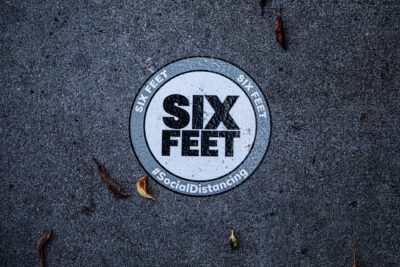Start the New Year Off Right at Work
There are a few easy things people can do to help themselves and their teams start the New Year on the right note when returning to work.

2020 is now coming to an end. Reset is in the air. Offices big and small are shutting down for the holidays. Streets are abuzz with lights. Everyone is with family and friends, in a festive mood, celebrating and making resolutions to start the oncoming year with success.
Unfortunately, things are rarely that simple. Kicking off the new year on a good start requires more than making resolutions – one has to plan well to make sure that the transition from festivities to coming back to work is actually a good one. Here are some easy-to-accomplish tasks that will help you set yourself and your business up for success.
Things to Remember on New Years’ Eve:
Stay Away from Overindulgence
We get it. With the festivities going around, the desire to give in to taking “just a little more” of that favorite food, drink, or even time to celebrate goes up to an all time high. However, it is always good to dial a bit low than the limit, especially when the next day will be a working day.
Plan the First Day of Return to Work in Advance
The first day back at work after a long period of holiday can be quite a handful. Having the smaller-yet-important decisions already made helps easing into the transition better. Before starting with the celebrations for the new year, make sure you have everything in order for your first day back. Pick an outfit, plan your meals, and set your morning alarm so that you can start your day on a high note.
Things to Remember on your First Day Back at Work in 2021:
Hydrate
Staying hydrated is always important, and even more so on your first day back. Make sure that you are having enough water as per your current requirement. It may happen that you will have to rehydrate more than usual, especially if you were engaged in festivities on the day before.
Change the Print
New year, new print. Just as the year 2020 is behind you, make sure that your prints and displays are too. Make sure to remove all of the outdated material and replace them with fresh, up-to-date ones from the get go. This includes old memos, notices, and of course, the calendar. Additionally, see to it that your brochures, signage and ads are all updated with the current year.

Give Your Team a Warm Welcome Back
Having your team on board is essential – not just physically but also in spirit. Ensure that all your employees, regardless of their position and/or location feel welcomed and spirited as they step into their first day back as well. There are several ways you can go about this. For starters, send every one of your employees a New Year greetings email to show them your appreciation of their hard work. Other things you can do is throw a welcome back breakfast or lunch (which is admittedly more suitable for on-site employees), or give/send them a small gift as a token of appreciation (this works for both on-site and remote-working employees).
Look Ahead
Learning from the past, and its successes and mistakes is important. Dwelling on it, however, is definitely bad – both of business and for the health of you and your employees. Ensure that you do not repeat the errors you may have made in the previous year, but also be kind to yourself. You have a whole year ahead to yourself – beating yourself up over the past will only prevent you from embracing the future!
Google Outage Leaves Internet Users Stumped
Did your Google services stop working, and refused to work even after you cleaned up you cache, rebooted your PC, checked your wiring, and even called your Internet Service Provider to find out if everything was alright with them? Well, it wasn’t you – this one time, it really was Google.
On Monday, the 14th of December,2020, most of Google’s services – including Google Classroom, Google Docs, Gmail, YouTube, and even Google assistant had rendered unresponsive to users, sending them a ‘503’ or a ‘502’ error instead. Both these numbers related to server failures – while 502 is a bad gateway error that indicated discrepancies between the origin and edge servers, 503 means that the server was unable to handle the request. Such messages were displayed on both of Google’s personal and business versions of its services.

The sudden “disappearance” of Google’s services, which is said to power of 97% of internet users daily activities caused mass panic among people. Popular social media platforms, especially Twitter ran amok with frantic users discussing on why they couldn’t access even the most basic of Google services. Many of these users also reported problems with other services that relied on Google. This included smart gadgets such as Nest Hub, and third-party apps such as Pokemon Go.
Notably, despite the outage, Google core search engine continued to run without a glitch, as did the third-party advertisements. Furthermore, many users reported to having their Google services work if they used them on a desktop browser in incognito mode. If anything, this only added to the confusion.
It didn’t take long for Google to jump into the action, though. The tech giant did not hesitate to acknowledge the issues with its services, and within an hour of this had all of its issues resolved. Once the services were back to normal, Google added special notices on each of its services that had stopped working – in order to assure users that everything was indeed back to normal.
According to Google Cloud Services, the outage happened because of an error in their identity management process. Apparently, a glitch in their automated quota management system had considerably reduced Google servers’ ability to verify users’ identities, thus causing them to display the 503 error. The problem indeed intensified to a state where all of Google’s services had gone down.
Effects of the outage were felt worldwide. Top software status monitoring platform DownDetector showed that the issue hit users in most (if not all) countries in the world. Reports were seen everywhere – including (but not limited to) Australia, Japan, India, United Kingdom, the Netherlands, France, Argentina, and of course, the United States, which was by far the worst hit of them all.
Update on COVID-19 Contact Tracing App from Google and Apple
A few months ago, we discussed about the revolutionary partnership between Google and Apple. Both of the rival tech giants signed up to make an app to make COVID-19 contact tracing a more effective and efficient process.
Contact tracing apps are not new as a concept, but they tend to have very low download rates. Take, for example, the state of Virginia, whose contact tracing app launched earlier this year was downloaded by a grand total of 11% of the state’s population. Google and Apple’s partnership solves this problem as both are heavily used in the US (and worldwide), and the app will be downloaded with a simple system update.
After a period of over 8 months (the original announcement was made in April 2020), the app’s much-hyped launch in California is finally happening. Officially called ‘CA Notify’ the app uses the contact tracing API added to both Android and iOS platforms in May. In can run on Android 6.0 phones and above, and iOS 14.2 and above, along with Bluetooth Low Energy.

Basically, the app takes Bluetooth signals and uses them to send and receiving anonymous “keys” between mobile phones that are within Bluetooth range of each other. That way, when someone has been Covid-19, all the need to do is enter their test result into the app. Those phones that exchanged “keys” within 6 feet (or 2 meters) of the patient’s phone will automatically be alerted.
Those fretting over privacy concerns can rest easy too. Not only is the app fully secure, it is also entirely opt-in. Plus, it does not personally identify the phone’s owners, or even use any of the location data. All the communication is done through the unique “keys” that are shared over Bluetooth.
Launching the contact app statewide makes California the largest state to adopt the built-in technology – in terms of population. The reception here appears to be warmer than most too, perhaps in part because the state is home to the HQs of both Google and Apple, in general is known to be tech-savvier than most.
California Governor Gavin Newsom has high hopes with the app and has even made a statement in public on how he expects the state to have much better adoption rates – given the level of familiarity. They were also specially promoted by Apple’s Tim Cook and Google’s Sundar Pichai.
The US states that are currently using this technology include Alabama, Arizona, Colorado, Connecticut, Delaware, Maryland, Michigan, Minnesota, Nevada, New Jersey, New York, North Carolina, North Dakota, Pennsylvania, Virginia, Washington, Wyoming, and District of Columbia.
Instead of having a single contact tracing app for the entire country, there is a basic app that is customized for each of the states that have decided to opt-in. The process starts with the state’s premier public health authority to sign up for the Exposure Notification API. The health authority will then create an Android app, and an iOS app tailor-made for their region that will support said notifications.
Preparing a Business for Winter Holidays
Best practices for business during the end of year holiday season.

As the holidays draw closer, there is much preparation to be done. For business owners, there is a lot more to be considered and it is not always clear what needs to be accomplished during this time. Even some of the most basic aspects of business operations, such as announcing changes to hours, are commonly overlooked throughout this time of year. To help make winter holiday preparations for businesses less challenging, we have comprised a short list of best practices that may help your business be more successful than ever before.
Update Business Hours of Operations
Hanging a “Closed” sign on a business’ door will get the message across to anyone that tries to visit but, it will also be aggravating if it happens to contradict the business hours that are published online. This is especially true if the business is hospitality or retail. Now more than ever consumers check online to determine when a business is open. Misinformation may quickly lead them to seek out a competitor.
There are three main places where these updates should be applied online, at the very minimum. Those places being 1) the business website, 2) business profile on Google, and 3) Facebook. If you are a restaurant or caterer, you will also want to update any Yelp listings, if applicable. These are the most popular places people go to check when a business is open. Keeping them up-to-date is a fundamental part of managing a business and providing good customer service. If there are other websites or profiles where the hours changes can be applied then we highly encourage a business take the time to do so.
Create a Closing Checklist
Yes, that is right. We are essentially suggesting a checklist within a checklist but, bear with us a moment while we explain. Most if not all businesses, especially those with employees, have particular steps set out for closing time. These procedures maybe written out or just a mental checklist for the normal closers. However, during the holiday season it is common for vacations to be taken, shifts to be changed around and the business facilities to be unoccupied for longer periods than normal. Therefore, it is important to provide every employee with the steps that need to be done in order to safely and securely close up shop.
When making a checklist of closing procedures, a manager needs to make special considers for their type of business and facilities. Does the building or office need to be winterized for the 3-day Christmas weekend? Have all appliances been turned off and unplugged? Are security systems armed and doors locked? It is worth taking to time to make sure all that can be done is done right so you can enjoy your time away from work with a little less worry.
Share the Spirit of the Season

If you are able to give gifts, donations or simply thanks with festive celebrations, then why not share it with the world? Many people are pleased to see a company actively giving back. Whether a business owner is throwing a holiday party for staff at the office, passing out toys to less fortunate children or hosting a gala, it is worth a the extra effort to photograph the event and share it with the general public.
Do not feel bad if your business is not able to do much this year. Sharing what you have and your thankfulness is more than enough for people to appreciate. Allowing the true spirit of the season to shine through your business in any way possible not only helps to humanize the brand but also creates opportunities to reach and engage new audiences.
Some of the best tools to use to share these experiences are likely already at your fingertips. Many professional choose to post details to a blog or a page of their website designated for such occasions. Those posts are then shared across a business’ social media. When posting to social media, we recommend tagging any charities and partners you are working with to make an event happen. You may also want to create a Facebook event to increase participation and awareness if you are a main organizer.
Businesses that are current clients of Leads Online Marketing can make quick, easy work of this task by submitting a support ticket requesting posts to their website, blog and/or social media accounts. Just make sure to send us all necessary details and within 24-hours we will be sure it is published or scheduled to publish at a time you have designated.
Sales, Deals, Discounts and Clearance Events
A promotion is not much of a promotion if it is never properly promoted. Try saying that 3x fast. All joking aside, this is an all too common problem for small businesses. A business may have a sales event running but returning customers and potential customers have no way of knowing about it. There may be a physical sign in the store or a service person may mention it but this is not an efficient way to increase sales. Details of any sales and special offers are best published to the business website along with social media unless it is a highly exclusive offer.
For businesses that still utilize print advertisement, a high quality digital copy of all ads should be requested from the graphics designer and forward to the website developer for online publication. In most cases, a business is paying an advertising company to create the graphic (the ad image) in addition to the actual printing and distributions. So, many times the business holds the rights to reuse that graphic as seen fit including in use for online display ads.
These are just a few things that business owners, operators and managers should do to prepare for this time of year. The L.O.M. team understands that ever business is unique, which is why we offer customized marketing programs to meet your exact needs and budget. If you feel overwhelmed by trying to create or manage an online presence for your business, then we encourage you to give us a call to discuss how we can help your business stand out across the web.
We wish you all a happy, healthy holiday season and thank you for your support this year!
Now on to planning for 2021!

Fleets: Twitter’s New Feature Creating a Storm in the Social Media World

Among the many changes that characterize 2020, one of the biggest is the ones in social media features. With social media usage having skyrocketed, primarily due to the COVID-19 pandemic, platforms are scrambling to get to the #1 position. Think Facebook’s redesign, TikTok taking the world by storm (even as lawsuits pile up), Instagram introducing ‘reels’ for short-form video, and LinkedIn introducing widespread live feature and stories. The latest wave is being created by Twitter with its ‘fleets’ rollout. Having rolled out in Japan in mid-November, the feature is now available all over the world on desktop, Android and iOS.
Much in line with the ‘stories’ feature available on Instagram, Facebook and WhatsApp, fleets allow Twitter users to create “temporary” posts in the form of images, videos, and/or text. Fleets can be of 3 types. The first is text fleets, which is basically text on a plain or colored background. The second is photo/video fleets, where users can post both recorded and third-party media. The third type is share tweets. As the name suggests, this allows users to share their own tweets or those of others that catch their eye.
In a way, it is much like stories. Fleets appear on the top of the Twitter news feed (in both the app and desktop versions). Additionally, fleets can be live for only as long as 24-hours, after which they will automatically be deleted. Last but not the least, those with open messaging that have their story viewers send their reactions, and then continue the conversation in the private messaging area. What is not the same, however, is the purpose for which these fleets are designed. According to Joshua Harris and Sam Haveson, Twitter’s Design Director and Product Manager respectively, unlike stories, the point of fleets is to take the steam off of general news feeds.

The inspiration for the feature itself comes from the mounting Twitter post drafts, which they believe are due to the pressure of making statements that will stick, and having to deal with public replies. With features, these Tweet drafts, which have been “left in the dark” will get exposure through fleets, where the amount of self-consciousness will be significantly lower.
Another important element that is wildly different from stories is that Twitter allows users to work on collaborative fleets, which allow two posters to have a single tweet. These appear in the form on twin bubbles, instead of the standard single-bubble display. This particular element, however, is only available in specific regions thus far.
So far, Fleets have appeared to serve their purpose. The feature has been especially popular among general users, with many having increased activity on the social media platform. Many “lurkers” and passive users are also being seen posting their own fleets, or at least sharing others’ tweets through them. Yet others have been seen reducing their regular posting and focusing on Fleets. That’s not necessarily a bad thing, though. New features often end up attracting a lot of attention at the cost of regular ones, especially in the beginning of the rollout phase.
As a feature, Fleets do seem to have a very promising future. While the number of functionalities are low at the moment, that is soon to change. Many new features, such as AR integration, stickers, colors and customization, will soon be available for users to unleash their creativity through.
Businesses Need a Good Web Presence to Survive a Pandemic and Beyond
In this age of coronavirus pandemic, online presence management has become more crucial than ever before for small businesses.

The COVID-19 pandemic has completely turned the world upside-down. With a global toll of 33 million cases (and counting), and no definitive vaccine, intense lockdowns and quarantines have become more the norm than the exception. Homes and rooms have now become the center of activity for practically everyone – with people both living and working from home. The business world has borne the brunt of this impact as well – many a great company have withered and died in the multi-faceted chaos that the coronavirus has caused. It goes without saying that in situations such as these, having a subpar web presence is not an option for any business, let alone small businesses.
All said and done, it does not always have to be this dreary – especially if you are a small enterprise. Despite the uncertain times, the one decisive factor remains – with more people stuck in place, more and more people are spending time on the internet. For small businesses especially, this can be a distinct advantage. Large-scale businesses need premium solutions and wide-ranging campaigns to stay relevant and consistent with their customer base. Smaller ones, one the other hand, can start converting by amping up their online presence with the right combination of free solutions and constant involvement with customers and prospects.
Here are 5 ways in which small businesses can ensure they have a good web presence:
Take Advantage of Business Listings
Getting themselves listed in business directories is one of the first and best steps any small business can take towards building up their online presence. Some of the major directories serve multiple purposes. First and foremost, they help customers find key information about the store in one place. This includes the location, areas served, products and services, and contact information. Secondly, these listings also have reviews and rating scores provided by past customers, which gives businesses their much-needed authenticity. Last but not the least, the more listings a business has that are consistent with accurate information, the better it may be for their website ranking and Search Engine Optimization (S.E.O.) efforts.
Many business directories such as Google My Business, Yelp, Better Business Bureau and AngiesList offer basic services for free. Any small business can and should immediately take advantage of this by claiming their place (i.e. if they haven’t already). As a rule of thumb, owners should regularly check and update their business listings with relevant information such as description, business hours, location, email, phone number, and social media handles. Adding new images of the business and asking customers reviews on these listings is also highly recommended especially on Google.
Amp Up Your Social Media Strategy
Social media has already been the center of online activity for most, and the COVID-19 pandemic has made it even more so. This is a prime opportunity for small businesses to reach out to and engage with potential customers through social media platforms. In the event that you don’t have dedicated company social media pages, getting started is easy and is completely free to begin with. That said, most business tend to have accounts on major social media platforms such as Facebook, Twitter, LinkedIn, and Instagram – this makes it a matter of keeping them populated.
Make sure that the social media pages are optimized for searching, have all the up-to-date business information, and a consistent supply of content. This can include website links (such as blog posts), business images and media (mainly videos), comments on current situations, and even interactive content such as giveaways and polls. If your product and/or service can be sold online, you can even integrate social shopping. Make sure to reply to comments and messages – this shows that you as a business are proactive and ready to engage with your followers – customer or not.
Make Sure You Have a Professional Website
In today’s day and age, a website practically functions as a business card. It will be a go-to resource for both current and prospective customers, making it critical for businesses to keep theirs completely up-to-date on all points. This can only be possible by having a professional website. Contrary to a standard website, which has basic design elements, supports basic texts and pictures, and has no SEO optimization, professional websites offer businesses the ability to add every feature they could possibly need.
Flexible in nature, professional websites support the latest and the best off-page, on-page and contextual SEO, which helps them rank higher on search engines -and helps the business stand out online. They can support any type of design aesthetic, along with interactive features such as photorealistic imaging, virtual tours, polls, contact forms. Last but not the least, you can also include the online sales of your products and/or services through these websites through ecommerce plugins and online ordering, both of which can be easily integrated here.
Be Proactive in Promoting Your Brand

Having a great professional website with adaptive design, engaging social media pages, and high-end features are definitely the best way to start when boosting your online presence, but people do need to know more about them. In a world of competition and abundance, the only way for a small business to make themselves known is by proactively promoting their brand. The best way to go about this is through paid advertising. This is a technique that allows businesses to improve their online presence by promoting their business on Google, top search engines and social media.
There are a few types of paid advertising. One of these is Pay Per Click Advertising (PPC) – these are the advertisements that typically appear on the right side and top end of search engine results. As the name suggests, these charge by the click made by a prospect. Another great method is online display advertising. These are featured on the top, side, and bottom of various websites. Besides the obvious, these advertisement methods help businesses collect important data such as behavioral and contextual metrics, which in turn helps them streamline their online marketing and advertising better.
Improving your web presence may seem like a daunting task, but it doesn’t have to be that way. The above-mentioned ways can help small business cement their place online, draw prospects and convert sales in the best way possible.
A Few Things to Consider Before Building a Business Website
They say “organization is the key to success” and, without any organization we are unlikely to achieve our full potential. This has never been more true than it is now in our fast pace digitally driven world. Most business owners and directors, whether mindful of it or not, use this mantra every day. From the planning of the business and opening to daily operations and management, organization is important. In this article, we will discuss how organization plays a key role in building a business website.
There are a few things you need to figure out before jumping into the process of building an online presence. If you are having a hard time making a decision, contact your representative at Leads Online Marketing who will be happy to help you understand your options and make the best choice.

Business Branding
Branding is the way your business is perceived by others, and being consistent with the use of your brand will make it stronger. Along with selecting a good logo, a business owner will want to determine the business’ personality and a color scheme. Consider what mood or tone you would want to convey to a potential customer with a first impression. Incorporate your final choices into your whole business plan and keep the branding consistent.
In addition to the brand personality and style, we also recommend writing out a slogan, mission statement, a general description of your company and team. This is not something to be kept to yourself in a file somewhere. Pass it along to your business website designer to be added as public content. Once that is done, any random individual should able to engage your brand and have a clear idea of what you do and what sets you apart from the rest.
Remember, your brand needs to remain uniform across its website, social media, and even in print.
Page Content
You will need more than a brand and about section to make a successful website. Any and all products and services offered should be discussed somewhere on the website. The more relevant quality content available the better. One reason for this being is that Google favors web pages with high standards of content. Also, and in some ways one in the same, users should be able to learn as much as they want about your company just be browsing the website.
It is not uncommon for users, also known as potential customers, to rule out hiring a company because they were dissatisfied with the website content. This can be due to a seemingly simple questions they could not find an answer to or a service not found listed, and that person is likely to hire the competitor with the website that was most useful. No need to worry about being a good writing. As long as you are able to provide a comprehensive list of service and/or products with as many details and resources as possible, our team of content writers should be able to put the information to good use on your site.
Text is not everything when it comes to webpage content as photographs and images are great attention grabbers and can help it stand out. Set yourself apart by provide plenty of visual references to products, on-site work, projects and even your team members.
Purpose
Is there another purpose to your website other than supporting your brand and promoting leads? Consider adding other useful sections to your website such as customer forms, appointment scheduling, instant price quotes, helpful links etc. Get a clear idea of what functions you want your website to perform, make a list, then call us to discuss how to make your ideas a reality.
Having these matters sorted out before building a business website can save you and your website builder precious time and resources needed to make your business successful. Leads Online Marketing makes the process easier by assigning you a personal representative who will continue to be available to address any questions or concerns even after your site is fully launched and ranking well.
Google and Apple Team Up to Combat the COVID-19 Pandemic

For months, we have seen more markets, factories and trade centers shut down. Many businesses have either stopped operating, shifted to online, delivery and pick-up only, or a work-from-home model while millions of people have lost their jobs or taken cuts in their salaries – and all of this as most among the healthy remain confined to their own homes. Even with the virus peaking, the United States is preparing to loosen restrictions in order to get the economy stimulated again while still hoping to mitigate the spread of the virus. At such a critical time everyone should be following appropriate guidelines to try to ensure the health and safety of our communities but, as we know, this is not foolproof. And brings to light the importance of tracking person-to-person contacts when they do occur.
In an age when “social distancing” is the norm, the world got a new surprise when tech rivals Google and Apple announced a team up to create and launch a contact tracing system. The goal is to help the public and governments trace the activities of the people infected with COVID-19 and gather real-time data on the spread of COVID-19 while also alerting those that may have been exposed.
Contact tracing as a task is as straightforward as it sounds – it is set of processes followed in the event of the spread of various infectious diseases (such as the novel coronavirus) wherein epidemiologists and health care workers trace all the people the diseased had contact with. Once this location has been completed, the various persons in question are tested, and if required isolated so that they can be treated and do not end up spreading the disease further. The same process is repeated for each contact till no evidence of infection is found.
In the older years, this was extremely difficult, if not impossible – despite the fact that people did not travel at the pace at which they are now. Most notably used for measles, Ebola, and HIV, the process of contact tracing involved multiple phone calls and visits, along with long-drawn interviews. While the process is faster (and thanks to technology) simpler today, it still takes a few days at least to trace contacts for each patient. Wuhan in China seemed to have managed the situation with a team of 9,000 health workers who worked in teams of five. However, in other countries like Italy and United States, where the number of infected patients is much higher, hiring health workers exclusively for contact tracing is virtually impossible. The process is also tough in other economically challenged countries like those in Africa, South America and Asia, where resources are scarce to begin with.
Building upon these visible difficulties, the recommendations of various educational institutes and research bodies including (but not limited to) the University of Oxford and the European Data Protection Supervisor, and the success of similar contact tracing apps in curbing the spread of COVID-19 in countries like South Korea and Singapore, the app will maintain an automatic record of an individual’s whereabouts and contacts, and will constantly update areas that are most affected and most at-risk of developing the infection.
Such an app has some very key benefits to offer. Real time generated contact records will help health workers trace contacts without the drudgery of going through the process manually. This will help save vital time and bring in, test and treat the infected faster – preventing more deaths and infections. On the other hand, identification of hotspots and those generally at a higher risk will enable governments to enact proper testing and sanitization protocols, helping to curb the spread of the contagion.
With two tech giants working behind the project, no size or technical challenge will be too big. Given the fact that both Apple and Google have billions of users all over the planet, an app that works cross-platform unanimously will easily integrate into phones all over the world, irrespective of nationalities, languages and people’s lifestyle choices. So long as they have a smartphone, their movements can be traced.
If this were a few months ago, when the novel coronavirus wasn’t as much in the picture, such an app would be an appalling idea, with people rolling their eyes on governments’ desire to take surveillance to an all-time high. But now, this more than a tolerable idea because it isn’t just the governments but people who need to know where and how they can move safely. A large portion of the world itself is currently under lockdown, and while that does seem to be working, it simply cannot be a permanent solution. Moreover, even when the curve gets flattened and the disease does get contained, there is always a chance of a second wave of outbreaks. An app that traces the movement of people is more than the best way to avoid another unwanted outbreak of the deadly novel coronavirus – it is the need of the hour.
 |
| Help prevent the spread of the novel coronavirus by maintaining a physical distance of at least 6 ft between yourself and others in public. |
Your Guide to 5G
Among the various hot topics that currently rule news lines across the world the soon-to-be-commonplace 5G technology. A big leap from its predecessor – 4G – 5G, which is at least 20 times faster than the former, is already running pilot tests in major places all over the world and will be the norm in most countries by as soon as early 2020. The technology has a lot of press surrounding it – from being able to process at never before speeds and revolutionize the way we look at data processing to connecting the remotest of areas to the internet to possible health and environment concerns.
While we are yet to know how exactly the future of 5G will unfold, when it will reach different countries in the world, how it will change the way we work, and if there really are any considerable health concerns, it is imperative to know what 5G is and how it works.
What is 5G?
Short for ‘5th Generation,’ 5G is indeed the 5th generation of mobile internet connectivity that promises a more stable connection, faster processing speed, faster download and upload speeds and a level of connectivity that is much wider and broader than the current 4G. With 5G, you can bid adieu to buffering to the highest quality of videos and disruptions when you are sharing your videos – even in the most crowded of areas. And that, of course, is just the beginning. Carrying on from the analog cellular 1G, the TDMA, GSM and CDMA enabled 2G, the UMTS and HSPA 3G and of course the currently running LTE and WiMAX 4G, 5G will take internet speeds to hundreds of megabits, and not surprisingly even gigabits!
How will 5G affect service providers?
Almost all major communication service providers are currently running their 5G pilot programs, or at the very least have obtained their 5G licenses and are making their plans to take the best advantage this technology can offer. 5G will change the data landscape in a way that is similar to how 4G prioritized data plans and packages over phone call and SMS ones. With a much higher rate of efficiency, 5G will enable wireless devices to work at higher speeds, which will, in time, allow them to roll out new services and capabilities that were previously not possible. Of course, we are yet to see exactly what they may be and how they will affect each one of us individually.
Besides wireless technology, service providers using 5G-enabled fixed wireless access will also be providing a much better, never-seen before level of speed and connectivity, making businesses much more efficient and effective at their jobs and at budgeting.
How will 5G affect the world in general?
Whereas technology is concerned, the world is at a stage that was never before thought possible – Artificial Intelligence (AI), Virtual Reality (VR) and Augmented Reality (AR), and IoT (Internet of Things) are no longer fantasies and theories but the present reality we all live in. Given the speed at which this technology is expanding, we sure enough will need infrastructure that is capable of sustaining them. That’s where 5G comes into the picture. With its exponentially higher capabilities, 5G will not only allow us to take advantage of the current technology, but it will also pave the way to make room for tech that is even more efficient and unlock opportunities that we never thought was possible before.
5G is bound to touch and revolutionize every industry it touches – be it media and entertainment, finance, banking, security or healthcare.
Will 4G be gone for good?
The interesting thing about 5G is that while the other Gs, upon their introduction essentially retired their older counterparts (think 2G memes in 2014), 4G will remain here to stay, even with the proliferation of 5G. First of all because 5G will initially only be used to boost the current Long Term Evolution (LTE) networks as most current devices are in fact not capable of supporting 5G in its proper form. With time, and spread of full compatible hardware, 5G will stand on its own as a service.
And yet, at the same time, advancement in 4G technology will continue to take place – and 4G itself is expected to reach up to speeds of 2 Gigabits per second – which is in fact what the Qualcomm X24 modem, built into most 2019-manufactured 4G smartphones, is capable of.
Have we quietly stepped into a new age of quantum computing technology?
It all started when a NASA lab/Google Partner accidentally posted an online report that Google physicists had managed what is unattainable using the world’s current supercomputers. Even though it seemed the milestone of quantum supremacy had been accomplished the create was still not a full-fledged quantum computer.
While both the tweet and the paper were subsequently taken down, screenshots and copies are, of course, still available and moving in various channels of the internet. Unsurprisingly, neither party has responded to any and all questions regarding the claims, sending the whole world into a frenzy of questions and theories and begging the fundamental question whether quantum computing really has been achieved.
While that is still – and will seemingly remain up in the air for some time, let’s know what quantum computing technology really is and why it is the biggest thing ever to happen in the world of science and technology.
What is Quantum Computing?
Essentially, quantum computing is a level of speed and efficiency of computing that even the best and fastest computer right now cannot work at. A breakthrough like none other, computers using this technology will be able to solve the most complex of problems (that could take years or even decades) and solve them in a much shorter span of time.
The general belief among the scientific community is that at least 49 qubits are necessary to enter into the realm of quantum supremacy. The notable factor, here, is that qubits function in a way that is very diverse from the “classical” computer’s bits. In case of bits, they exist either as a “1” or a “0.” Computers, therefore, read and work on a single bit during a particular period of time. Qubits, on the other hand, can show combination of “1” and “0” because of peculiar quantum effects where properties such as momentum, particle position, and direction, aren’t solidly defined. A system based on this principle, can therefore solve in multiple states at the same moment – a phenomenon known as quantum indeterminacy.
In simpler terms, quantum computers can read and process “1s” and a “0s” during the same span of time, allowing for faster and better processing of information and allowing the system to act on processed information in real time. This, of course, will speed up the computing process exponentially and allow for speeds much faster than that of the current “classical computers.”
What is Google’s Contribution?
Truth be told, we can never say what is what until we get an official confirmation from the tech giant itself. What we do know, however, is that Google has been the leader when it comes to computing hardware and proved it’s leadership again recently when it unveiled its 73-Qubit processor that put competitor IBM’s 53-Qubit in second place.
That being said, the leaked NASA paper reveals that Google actually used a different – and a 53-Qubit (albeit originally a 54-Qubit) processor called Sycamore to make its demonstrations. The first step of the demo involved a classical computer being used as a ‘simulator’ to generate quantum instructions known as ‘quantum gates,’ the quantum counterparts of the logic gates utilized in classical computers. These were then sent to the quantum computer that would perform exclusively on qubits in pure zero states, and finally made to output samples from the probability distribution obtained from performing on the qubits. This was later cross-checked by running the same operation through the classical computer’s format in order to compare and contrast results. Quite expectedly, Sycamore did take a considerably less amount of time and did not cross the error threshold.
The question that arose here was that if a classical computer could in fact do the same operation, could scientists not tweak them instead of moving to a whole new principle altogether? Not according to Google’s scientist, who clearly published in their research paper that it would take the world’s most advanced computer at least 10,000 years for a computer working on the classic principle to achieve what a quantum computer would do in 200 Seconds – clearly an unmatched competition.
Now, when Google did manage to bring a success case from its 53-Qubit, it would only be a matter of time till it would achieve a similar level of success with its 73-Qubit as well. But the question is – has that already been done? Until Google does come out with it in the open, we can only call it a likely possibility. Right now, it is of course undeniable that Google is indeed leading the pack with its findings, and that its experiment with the Sycamore has made a breakthrough when it comes to computing.




